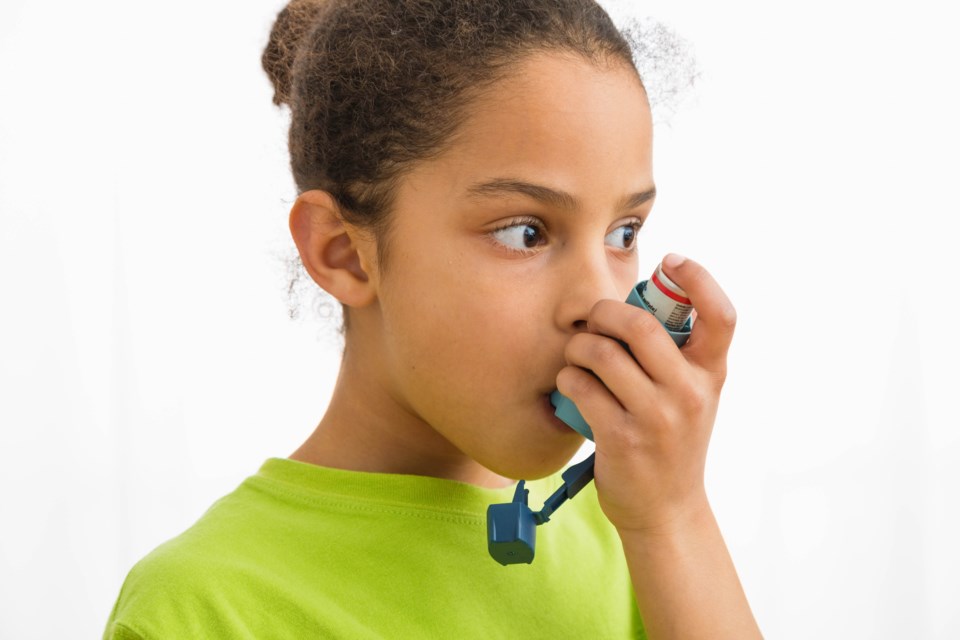The nerves and excitement of back-to-school may have passed, but season also brings with it factors that make the third week of September the perfect storm for asthma exacerbation, according to Dr. Mary Noseworthy, director of the Pediatric Asthma Clinic at the Alberta Children’s Hospital.
“It’s actually the time of the year when most kids are seen in emergency rooms, urgent care offices, and admitted to hospital for asthma exacerbation – adult and pediatric patients,” she said.
She added the September increase – about 20 to 25 per cent of yearly hospital admissions for asthma – is seen across North America.
Noseworthy said there are multiple reasons for the spike, including the change from the usually hot, dry summer to the cool, damp weather of fall. The cold air, not just the temperature change, she said, can also be a trigger for patients. Barometric pressure changes with Chinooks, mould in the air and other allergens can impact asthma, as well. However, the most frequent trigger – in 85 per cent of cases, according Alberta Health Services (AHS) – is the common cold.
“Kids are back in school in very small and closed environments with lots of other children. So, they’re passing flu bugs and colds around between each other,” Noseworthy said. “They’re sharing drinks and recess snacks and lunches, so there’s a lot of exposure to viruses that way, and they’re in close proximity to each other.”
She added viruses impact asthmatic, preschool-aged children, in particular.
“Coughing, wheezing from a viral illness can precipitate an asthma exacerbation, with coughing and wheezing that doesn’t go away after a few days with a common cold,” Noseworthy said. “It can get worse, and you can escalate your symptoms and your work of breathing can be more laboured.”
She said there are signs a simple case of the sniffles has become a more serious situation.
“You can actually have an audible wheeze, you could have nasal flaring, where your nostrils move in and out really fast. You can have sucking in the lower airway – which is basically the lower part of your neck sucking when you breathe in – and then the skin between your ribs can also get sucked in, as well, when you’re in a lot of respiratory distress,” Noseworthy said.
“When you have either of those three things, you really need to go to emergency.”
Other causes for the seasonal increase, according to AHS, include poor asthma management during the summer months, seasonable holiday and summer breaks from asthma medications, as well as back-to-school stress.
“Stress can be a common trigger for asthma – good stress and bad stress,” Noseworthy said.
Whatever the cause, many asthma-related hospital visits can be controlled with proper asthma management, according to AHS.
Ensure children take asthma medication as prescribed – even when the child is not displaying asthma symptoms, the medication can help avoid lung inflammation, AHS said. Routinely check or track usage of puffers to ensure the inhalers are not empty.
“You should be able to determine whether it’s empty or not by shaking it,” Noseworthy said. “Some inhalers do have dosages written on them and they dial down, like some of the turbuhalers – which are the combination inhalers – do actually have a red area when the puffer’s empty. Other inhalers actually have actual dosing on the inhaler itself, but sometimes you just have to either write on the box or make a manual recording of how many times you use the puffer.”
Knowing a child’s triggers and avoiding them will help, AHS said, as will an asthma action plan.
“That’s the plan that’s designed by your health-care provider and it tells you what to do when your child is having an asthma exacerbation,” Noseworthy said. “It’s just basically a step-up plan on how to treat your child’s asthma in a very organized fashion.”
She said the plan may include an increase in reliever-puffer use or inhaled corticosteroid, or taking allergy medication.
“All schools should have the children’s action plan, because, usually, they utilize the blue puffer – which is the salbutamol ventolin or bricanyl component – to use in gym class or when they have a cold,” Noseworthy added.
Finally, practicing consistent and correct hand-washing throughout the day and ensuring everyone in the family is vaccinated against the flu can help control asthma.
“I just wanted to remind all families with asthmatics in the family to get the flu shot when it comes out in October and don’t forget to wash your hands and decrease your exposure to work mates or schoolmates who have flu,” Noseworthy said. “Flu, again, is the most common trigger for asthma.”


